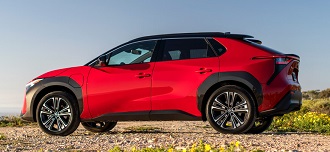Key specs
Toyota bZ4X (SUV) bZ4X 2022,2023,2024,2025
What is the body type, Toyota bZ4X 71.4 kWh (218 Hp) BEV 4WD 2022?
SUV, 5 Doors, 5 Seats
How many cylinders, Toyota bZ4X 71.4 kWh (218 Hp) BEV 4WD 2022?
Electric,
What is the drivetrain, Toyota bZ4X 71.4 kWh (218 Hp) BEV 4WD 2022?
All wheel drive (4x4),
How long is this vehicle, Toyota bZ4X 71.4 kWh (218 Hp) BEV 4WD 2022?
4690 mm
184.65 in.
How wide is the vehicle, Toyota bZ4X 71.4 kWh (218 Hp) BEV 4WD 2022?
1860 mm
73.23 in.
What is the curb weight, Toyota bZ4X 71.4 kWh (218 Hp) BEV 4WD 2022?
2005 kg
4420.27 lbs.
Toyota bZ4X (SUV) bZ4X 2022,2023,2024,2025 Specs
General information
| Brand |
Toyota |
| Model |
bZ4X (SUV) |
| Version |
bZ4X |
| Engine version |
71.4 kWh (218 Hp) BEV 4WD |
| Year production start |
2022 |
| Vehicle type |
SUV |
| Acceleration 0 - 100 kmh sec |
7.7 sec |
| Curb weight kg -lbs total |
2005 kg
4420.27 lbs.
|
| Overall length mm - inch |
4690 mm
184.65 in.
|
| Doors |
5 |
Engine specs
| Engine position and orientation |
Front axle, Transverse |
| Cylinders |
Electric |
| Weight / horsepower kg/hp - hp/tons |
9.2 kg/Hp
108.7 Hp/tonne
|
| Fuel type |
Electricity |
| Powertrain architecture |
BEV (Electric Vehicle) |
| Electric motor power |
109 Hp
|
| Engine location |
Front axle, Transverse
|
| Total available power |
218 Hp
|
Transmission and Drive system
| Drive configuration |
All wheel drive (4x4)
|
Brakes
| Front brakes |
Ventilated discs |
| Rear brakes |
Ventilated discs |
| Anti-lock brake system |
ABS (Anti-lock braking system) |
Steering
| Steering type |
Steering rack and pinion |
| Turning diameter m - ft |
11.4 m
37.4 ft.
|
Suspension
| Front suspension |
Spring Strut, Coil spring |
| Rear suspension |
Double wishbone |
Dimensions
| Overall length mm - inch |
4690 mm
184.65 in.
|
| Overall width mm -inch |
1860 mm
73.23 in.
|
| Overall height mm -inch |
1650 mm
64.96 in.
|
| Wheelbase mm - inch |
2850 mm
112.2 in.
|
Weights
| Curb weight kg -lbs total |
2005 kg
4420.27 lbs.
|
| Gross weight kg -lbs total |
2275 kg
5015.52 lbs.
|
| Capacities kg - lbs |
270 kg
595.25 lbs.
|
Engine type
Electric
https://www.thecarspec.com/components/engine/electric

